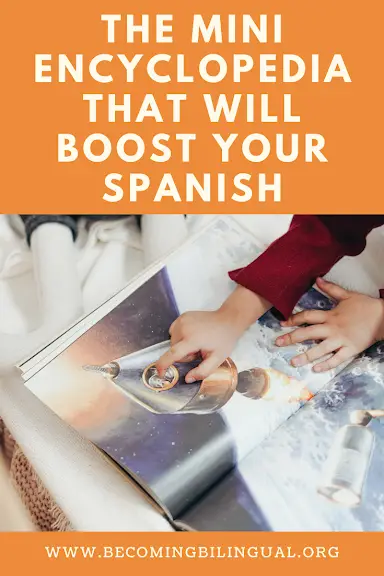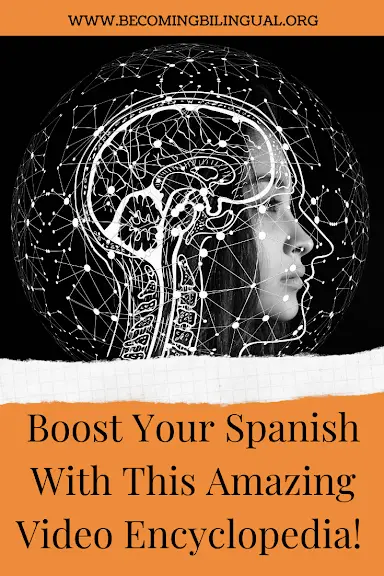The Mini Encyclopedia That Will Boost Your Spanish

Last Updated on January 18, 2021 by Reina Victoria
I’m always thinking about how I can improve my daughter’s Spanish – and my own! One thing that I can always improve upon, is our vocabulary.
During my bilingual parenting journey, I have found that it’s much easier to find Spanish resources that support basic vocabulary needs.
Many of the resources that are more readily available are nursery rhymes in Spanish, translated books and translated children’s shows.
While these have been valuable for building the foundation of our Spanish language skills, they don’t provide a deeper level of vocabulary acquisition, like academic vocabulary, literary adjectives, and content area vocabulary.
Table of Contents
How To Build Spanish Vocabulary
In a previous post, I talked about the question of raising a truly bilingual child and the importance of introducing and building academic vocabulary with your child. Finding materials to support content specific and more academic based vocabulary can be really hard to find in Spanish.
For more information on raising a truly bilingual child, read here:
The Challenges Of True Bilingualism In A Monolingual Culture

I’m always on the lookout for resources that can provide some academic or deeper content vocabulary to my daughter.
One resource that I’ve found to introduce basic content area vocabulary is the Netflix show, “If I Were An Animal…” It’s been a nice way to introduce my daughter to more scientific vocabulary including things like, “hibernate” and “camouflage” and the episodes are relatively short and entertaining – perfect for younger kids!
To read my full review of the show, click here:
An Educational Spanish Kids Show That You Need To See
Another resource that I’ve found is BrainPop Espanol.

The company BrainPop actually has several sites for a variety of learners including BrainPop, BrainPop Jr. and BrainPop ELL. There site has been around for over 20 years and they have been gradually adding content and new sections like “Game Up!”.
What Is BrainPop?
BrainPop Espanol is a like a mini vide encyclopedia of basic topics. All of their videos were created in Spanish, not translated from their English version.
The topics for their mini videos are categorized by theme: “Science”, “Art and Music”, “Health”, etc. so it’s easy to search for a topic that you’re looking for.
Their original English site is split into BrainPop Jr – for kids 4-7 and BrainPop – for kids 8-14 so that there are separate videos for younger and older kids.
However, BrainPop Espanol only has one section and I would say that it is geared toward older kids, similar to the BrainPop original site in English 8-14.
While it’s still a bit advanced for my daughter, there is a lot of benefit that I can gain from it. As a parent who’s a non-native Spanish speaker, I can watch the video first and pick up academic vocabulary about a specific topic that I can then use with my daughter. Then, if I think the video is appropriate for her, can let her enjoy it as well, so that we can talk about it together.
Here’s What We Like About BrainPop
Short Videos
BrainPop Espanol is like an encyclopedia of mini videos. When you search for a topic, a video pops up that usually under 7 minutes. When I search, “reptiles”, I see their reptile video that is 5:28min – short! But just because it’s short doesn’t mean it doesn’t have a lot to offer! The videos are basic and get the general points across. When I start watching the reptile video, it explains that reptiles look different from each other but that have common characteristics, like scales. After a few minutes I’m flooded with more of the content vocabulary that I’m looking for, “lungs”, “ectothermic”, “diverse”, “species”, “omnivores”, etc. The short animated video provides a good visual for the content vocabulary and it introduces some words that I wouldn’t be getting from the more common Spanish materials that are available.
Captions and Text Speed
When you’re watching the video, there are setting options that are attached to the video. One is “captions”. As a non-native speaker who’s looking to increase their Spanish language skills all the time, having the captions can be really helpful for me. Being able to read the Spanish words while listening to them at the same time can help me to remember the new vocabulary and see what it looks like when it’s written. There’s also an option for text speed, “normal” and “slow”. Being able to slow down the speed of the voice and animation can also be helpful to language learners who are listening for the first time.

Follow Up Activities
BrainPop Espanol is more than just a mini video. There are other follow up activities that you can do to check your understanding, explore the topic more, or engage with their site. One of the activities is “Cuestionario” it’s a short quiz that you can take after watching the video. The quiz is multiple choice and helps to solidify some of the language and concepts that you heard in the video. There’s also a section called, “actividad” which brings you to some sort of activity that’s related to the content. Sometimes the activity is a game or a sort that allows you to further explore the topic. There’s also a section called, “lecturas relacionadas” which brings you to a fact page, that includes a fun comic, trivia, and extra facts and figures related to the topic you selected.
Wide Range of Academic Topics
I mentioned before that it can be hard to find materials with content based and academic vocabulary in Spanish for kids, but some topics are harder to find than others. In general, I’ve been able to find some resources on things like animals and wildlife. But other topics like space, artists, and engineering are harder. The nice part about BrainPop Espanol is that they include a huge range of topics, not just in the sciences. You can go into their “Art and Music” category and find videos on “Photography”, “Frida Kahlo” and “Ludwig Van Beethoven”. The wide range of categories makes them a valuable site for content and academic language building all around.
For more information or to check it out for yourself, follow this link to their website:
If you’re looking to raise a truly bilingual child, then it’s important to develop their content and academic vocabularies as soon as you can.
Happy Learning!
What are some other academic resources that you use for your child? Let me know in the comments!
Don’t forget to subscribe here to get my latest posts and resources delivered directly to your inbox!